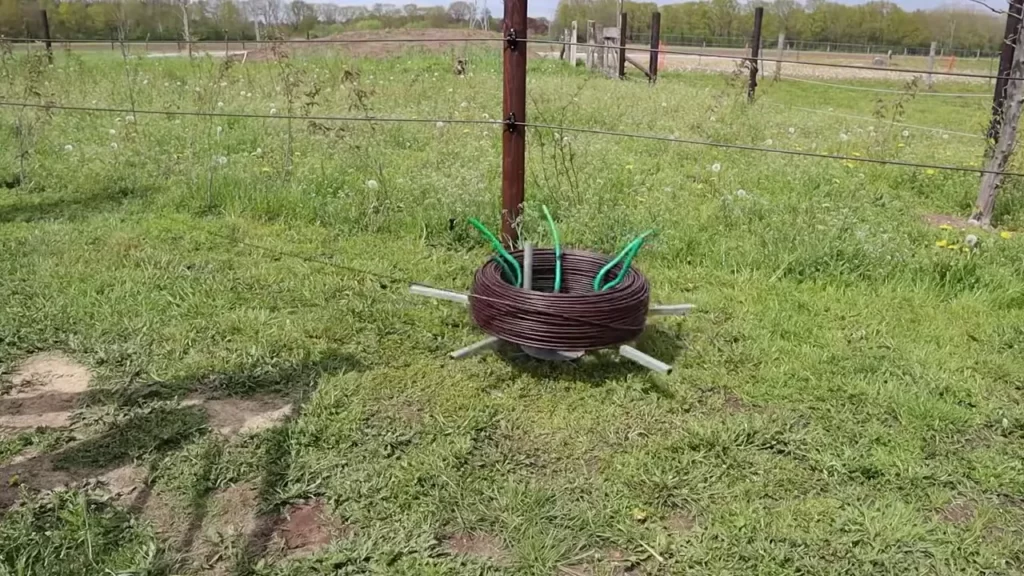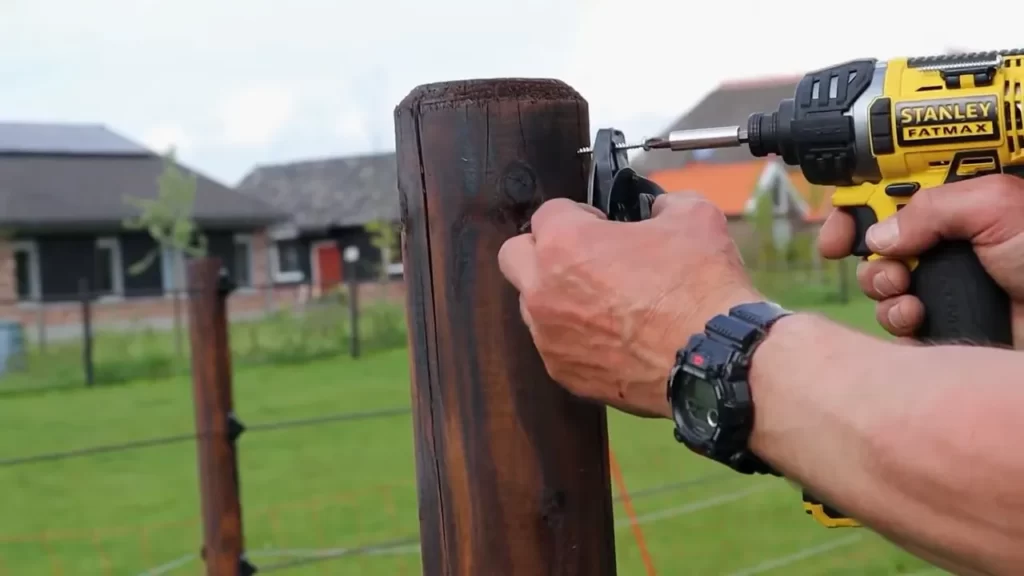Installing an electric fence for horses requires careful consideration and planning. In order to do it correctly, follow these steps: To install an electric fence for horses, follow these steps: carefully plan the layout, install the posts, attach the insulators, run the wire, and test the fence for effectiveness and safety.
Introducing an electric fence to a horse’s environment can be an effective way to keep them contained while allowing them the freedom to graze and roam. This type of fencing delivers low-level electric shocks that act as a deterrent, effectively training horses to respect boundaries.

However, installing an electric fence requires careful planning and execution to ensure its effectiveness and the safety of the horses. In this guide, we will walk you through the step-by-step process of installing an electric fence for horses, providing you with the knowledge needed to create a secure and controlled space for your equine companions.
Choosing The Right Location
When installing an electric fence for horses, choosing the right location is crucial. Evaluating the size and layout of the pasture area is the first factor to consider. Take into account the space needed for the horses to graze comfortably and ensure that the fence will encompass the entire designated area. Identifying potential hazards and obstructions is another important consideration. Look out for trees, rocks, or any other objects that could pose a threat to the horses or interfere with the fence installation. It is essential to have a clear understanding of the landscape to determine the best location for the electric fence. By carefully assessing the pasture area and surveying for potential obstacles, you can ensure the fence is installed in the ideal location for the safety and security of your horses.
Measuring And Preparing The Area
Are you considering installing an electric fence for your horses? To ensure a successful installation, the first step is to properly measure and prepare the area. Gathering the necessary tools and materials is essential for a smooth process. Make sure you have everything you need before starting the installation.
Next, measure the perimeter of the pasture where you plan to install the electric fence. This will help you determine the amount of fencing and other supplies required. Additionally, clear any vegetation and debris from the fence line to prevent any interference with the electric current.
Installing Fence Posts
To install an electric fence for horses, it is important to first determine the spacing and number of fence posts needed. This will ensure that the fence is secure and will effectively contain the horses. Digging holes for the fence posts is the next step in the installation process. These holes should be deep enough to provide stability and support to the fence. Once the holes are dug, properly setting the fence posts is crucial. This can be done by either setting them in concrete or using insulators. Concrete provides a strong foundation for the posts, while insulators allow for flexibility and easy adjustment of the fence tension. By following these steps, you can successfully install an electric fence for horses that will provide security and safety.
Installing The Wire And Insulators

| Selecting the appropriate wire for an electric fence: |
| When installing an electric fence for horses, it is crucial to select the right wire. The wire should be strong, durable, and able to withstand the outdoor conditions. High-tensile wire is a popular choice for its strength and longevity. It is designed to handle the tension generated by the electric fence system. Polywire is another option, which is lightweight and easy to handle. It is recommended for temporary or portable fences. Lastly, electric tape is a visible and safe option for horses as it offers a better visual barrier. Ensure the wire you choose is compatible with the electric fence charger you plan to use. |
| Attaching insulators to the fence posts: |
| Insulators are essential components that prevent the electric fence wire from touching the fence posts and grounding the system. Porcelain insulators provide excellent insulation and durability. Plastic insulators are a cost-effective option, commonly used for temporary fences. Attach the insulators to the fence posts at regular intervals and make sure they are secure and do not move or rotate. |
| Running the wire along the perimeter of the pasture: |
| When running the electric fence wire along the perimeter of the pasture, it is important to follow a few guidelines. Start by determining the desired height of the wire, usually between 3 to 5 feet for horses. Attach the wire to the insulators on the corner and end posts, ensuring it is taut. Use tensioners to maintain the appropriate tension. Keep the wire at a safe distance from trees, buildings, or any potential obstacles to prevent contact. Lastly, regularly inspect and maintain the wire to ensure its effectiveness in containing the horses within the pasture. |
Connecting The Energizer And Grounding System

Choosing the right energizer is crucial for installing an electric fence for horses. The energizer is responsible for providing the electric charge to the wire, so it is important to select one that is powerful enough to deliver the required shock to deter the horses. Additionally, it’s important to ensure that the energizer is compatible with the wire and grounding system being used.
Installing a grounding system is another important step in connecting the energizer for proper functioning of the electric fence. The grounding system helps to disperse any excess electric charge into the ground, preventing the fence from becoming ineffective or dangerous. It is recommended to install at least three grounding rods, spaced several feet apart and driven deep into the ground.
Once the energizer and grounding system are in place, connecting the energizer to the wire and grounding system is straightforward. Follow the manufacturer’s instructions to connect the energizer’s positive terminal to the fence wire and the negative terminal to the grounding system. Ensure all connections are secure and protected from the elements to maintain a reliable electric fence for horses.
Testing And Troubleshooting
Installing an electric fence for horses is an effective way to keep them contained and safe. However, it’s important to test and troubleshoot the fence to ensure it is functioning correctly. Using a voltage tester is a simple and essential step in the installation process. By testing the voltage at various points along the fence, you can identify any issues and make the necessary adjustments. Additionally, troubleshooting common issues such as loose connections and short circuits is crucial for maintaining an efficient electric fence. Regularly checking the fence for any signs of damage or wear and tear is also important. Repairing any broken wires or insulators promptly can prevent further issues and ensure the fence continues to work effectively.
Additional Safety Measures

Additional Safety Measures:
Installing warning signs and visible markers is crucial when it comes to installing an electric fence for horses. These signs serve as a visual reminder for both horses and humans to be cautious and aware of the electrified fence. By placing signs strategically along the fence line, you can ensure that everyone knows there is an electric fence present.
Training horses to respect the electric fence is an important step in ensuring their safety and well-being. In order to do this, it is recommended to introduce horses to the fence gradually and with supervision. This allows the horses to become familiar with the fence and understand that touching it will result in an unpleasant but harmless shock. Consistency and positive reinforcement are key when training horses to respect the boundaries of the electric fence.
Lastly, regularly checking the fence for any damages or malfunctioning parts is essential to maintain its effectiveness. Ensuring that the fence is properly grounded and that there are no exposed wires or loose connections is vital for the safety of both horses and humans. By taking these additional safety measures, you can have peace of mind knowing that your electric fence is providing a secure and safe environment for your horses.
Frequently Asked Questions On How To Install An Electric Fence For Horses
How Do You Install An Electric Fence For Beginners?
To install an electric fence for beginners: 1. Start by planning and measuring the area you want to enclose. 2. Install the grounding system by attaching grounding rods to the fence charger. 3. Install fence posts evenly spaced along the perimeter using a post hole digger.
4. Attach insulators to the fence posts and run the wire through them. 5. Connect the wire to the charger, test the system, and make adjustments as needed.
Can I Install An Electric Fence Myself?
Yes, you can install an electric fence yourself. Just make sure to follow safety instructions, purchase the necessary equipment, install it properly, and test the fence to ensure it’s working correctly. However, it’s advisable to consult a professional or refer to the manufacturer’s guidelines for specific instructions.
Does An Electric Fence Have To Make A Complete Loop?
No, an electric fence does not have to make a complete loop. It can be designed as a single line or connected in different configurations to effectively contain or deter animals.
Conclusion
Installing an electric fence for your horses is a crucial step in ensuring their safety and security. By following the necessary steps, such as researching local regulations, selecting the appropriate materials, and properly grounding the system, you can create a reliable and effective barrier.
Remember to regularly inspect and maintain the fence to keep it in optimal condition. With the right approach, you can provide your horses with a secure environment that allows them to thrive and roam freely. Safeguard your beloved animals and enjoy peace of mind with a well-installed electric fence.
